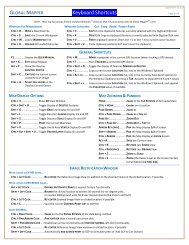Map GPS Coordinates - GPS Map Coordinates ... - Global Mapper
Map GPS Coordinates - GPS Map Coordinates ... - Global Mapper
Map GPS Coordinates - GPS Map Coordinates ... - Global Mapper
You also want an ePaper? Increase the reach of your titles
YUMPU automatically turns print PDFs into web optimized ePapers that Google loves.
<strong>Global</strong> <strong>Map</strong>per User's Manual<br />
• Elevation Grid - All lines from the file which are determined to contain 3D coordinate data will be<br />
use generated a triangulated terrain which is then gridded to create a elevation grid. This grid has all<br />
the capabilities of an imported DEM, including contour generation, line of sight and view shed<br />
analysis, and raster draping. When selecting this option, the Create Elevation Grid dialog will appear<br />
after setting up the ASCII file import options to allow setting up the gridding process.<br />
The Coordinate Column Order section allows the user to specify in what order the coordinates are found on<br />
coordinate lines in the file. <strong>Coordinates</strong> can either be x followed by y (i.e. longitude then latitude) or the<br />
reverse. Elevation values, if any, are always assumed to come after the x and y values. The Fields to Skip at<br />
Start of Line setting controls what field index (column) the coordinates start in. For example, if the x and y<br />
coordinates are in the 3rd and 4th columns, set this value to 2 so that the coordinates will be grabbed from the<br />
appropriate place.<br />
The Coordinate Delimeter section allows the user to specify what character the coordinates are separated by<br />
on coordinate lines. If the Auto-Detect option is selected, <strong>Global</strong> <strong>Map</strong>per will attempt to automatically<br />
determine the coordinate delimeter. This option will usually work and should probably be used unless you<br />
have trouble.<br />
The Coordinate Line Prefix section allows the user to specify whether coordinates start at the beginning of the<br />
line or if coordinate lines start with some other sequence of characters. For example, some formats may start<br />
coordinate lines with the sequence "XY,".<br />
The Rows to Skip at Start of File setting controls how many lines to skip at the start of the file before trying to<br />
extract data. This is useful if you have some header lines at the start of your file that you want to skip over.<br />
The Feature Classification section allows the user to specify what feature type to assign to area, line, and<br />
point features imported from the file.<br />
If the Include attributes from lines with coordinate data option is selected, any text found AFTER the<br />
coordinate data on a line from the file will be including as attribute for the feature that coordinate is in. If not<br />
selected, only lines from the file that are not determined to contain coordinate data will be used as attributes.<br />
If you are doing a Point Only import and the Column Headers in First Row of File option is checked, values<br />
in the first line from the file will be used at the names of attributes for attributes found in coordinate data lines.<br />
This is useful for things like CSV files.<br />
If the Treat 3rd coordinate value as elevation option is selected and a numeric value is found immediately<br />
following the x and y (or lat and lon) coordinate values, that value will be treated as an elevation. Otherwise,<br />
the value will be included as an attribute if the Include attributes from lines with coordinate data option is<br />
selected. Typically you want to leave this option checked unless you are importing point data in which the 3rd<br />
column is an attribute that occasionally contains all numeric values, such as well names.<br />
If you have line and/or area data that do not have non-coordinate lines separating them but rather are delimited<br />
by a change in a particular field/column of data, you can use the Break Line/Area Features on Change in<br />
Field option to specify which field (use a 1-based index) to check for breaking the data into separate line/area<br />
features.<br />
Pressing the Select Coordinate Offset/Scale button displays a dialog that allows the user to select an offset and<br />
scale factor to apply to each coordinate. The offset entered will first be added to each coordinate, and then<br />
each coordinate will be multiplied by the scale factor.<br />
<strong>Map</strong> <strong>GPS</strong> <strong>Coordinates</strong> - <strong>GPS</strong> <strong>Map</strong> <strong>Coordinates</strong> - <strong>GPS</strong> <strong>Coordinates</strong> <strong>Map</strong> 11







